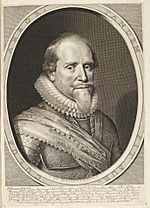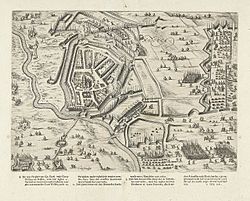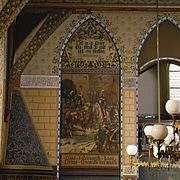Siege of Steenwijk (1592) facts for kids
Quick facts for kids Siege of Steenwijk 1592 |
|||||||
|---|---|---|---|---|---|---|---|
| Part of the Eighty Years' War & the Anglo–Spanish War | |||||||
 The siege of Steenwijk in 1592; print from Atlas Van Loon: The detonations of the mines are made visible. |
|||||||
|
|||||||
| Belligerents | |||||||
| Commanders and leaders | |||||||
| Strength | |||||||
| 6000 troops 2000 cavalry |
1060 300 (relief) |
||||||
| Casualties and losses | |||||||
| 600 casualties | 550 casualties 800 surrendered |
||||||
The Siege of Steenwijk was an important battle that happened from May 30 to July 5, 1592. It was part of two bigger wars: the Eighty Years' War and the Anglo-Spanish War. A combined army from the Dutch Republic and England, led by Maurice of Orange, fought against Spanish forces.
Taking Steenwijk was key because it controlled one of the main land routes to Groningen. The other main route was at Coevorden. After trying to bomb the city, the Dutch and English attacked. They used special underground tunnels called mines to blow up parts of the city's defenses. When two out of three attacks succeeded, the Spanish soldiers gave up on July 5, 1592. They handed the city over to the Dutch and English army. This siege was one of the first times in history that soldiers called pioneers were used as a separate military group.
Why Steenwijk Was Important
Prince Maurice of Orange had been very successful in his military campaigns since 1590. He started by capturing Breda and then took other important cities like Nijmegen. During these battles, Delfzijl was also captured. This meant that the city of Groningen was slowly being cut off from supplies and help.
The Dutch leaders decided to start their next campaign by attacking Steenwijk. Steenwijk was a very strong city on the route from the IJssel river at Deventer. Capturing it would help cut off Groningen even more. Some leaders wanted to attack other places, but Steenwijk was chosen.
At this time, the main Spanish commander, the Duke of Parma, was fighting in France. This left Ernst I von Mansfeld in charge. Francisco Verdugo was the Spanish governor, or Stadtholder, of the areas around Steenwijk.
Steenwijk is located in the northern part of the Overijssel province. It is close to the Zuyder Zee. The city had been attacked before in 1581. But a relief army, led by John Norreys, had saved it. However, in November 1582, Spanish forces led by Juan Baptista de Tasis took Steenwijk. They had held it for Spain ever since.
On May 28, 1592, Prince Maurice's army set out. He had 6,000 foot soldiers, 2,000 cavalry (soldiers on horseback), and 50 cannons. The English part of the army, led by Francis Vere, had 1,344 men. This included 12 companies of infantry and 4 groups of cavalry. Maurice was able to bring his large siege cannons and equipment by water.
The Siege Begins

On May 7, 1592, the Dutch and English army set up camp around Steenwijk. They began digging trenches and earthworks around the city. Steenwijk was defended mostly by a local army of 16 companies of foot soldiers and some cavalry. These were led by Antonio Coquel, the military governor. There were also 1,000 pro-Spanish Walloon soldiers. The city had been made stronger with earth walls and had plenty of supplies.
Francisco Verdugo wanted to send more troops to protect Steenwijk. But most of his soldiers were fighting in France. Also, Ernst I von Mansfeld refused to send troops from another area, saying it was more important to hold those places.
The Dutch and English dug their trenches mainly on the south side of the city. They built a high mound, called a cavalier, which was 19 feet tall. From this mound, they could fire their cannons down onto the city's walls. All the cannons were moved into place. The English soldiers directed the digging on their side. By June 10, the attackers had reached the outer ditch, called the counterscarp, on all sides of the city. They also built small forts, called sconces, to protect themselves from any Spanish relief army.
On June 13, the cannons began firing at the city walls. They fired 6,000 cannonballs on the first day alone. During the siege, Maurice used new ways of attacking. Usually, farmers were hired to dig the trenches. But this time, the soldiers themselves did the work. They were formed into special units called pioneers. They worked under Maurice's military engineers, Joost Mattheus and Jacob Kemp. This was very new and one of the first times in history this method was used in battle.
Fighting and Mines
On June 19, the Spanish defenders sent a group to talk about giving up. Maurice met with them but demanded that they surrender completely, without any conditions. The talks failed, and the bombing started again. But the city walls were so strong that the cannons couldn't make a big enough hole to attack through. In total, 29,000 cannonballs were fired, but they caused little damage to the walls or the city.
Soon after, Francisco Verdugo tried to send 300 experienced Spanish soldiers to help the city. But most of them were killed or captured trying to get past the Dutch and English lines. Only 60 soldiers made it into the city. The Spanish also tried to make several quick attacks, called sorties, out of the city. These attacks damaged the Dutch and English siege lines and even captured some prisoners.
On June 23, a small fort, called a ravelin, on the west side was captured by a Dutch attack group. This meant that the attackers could now start digging mines. Mines were tunnels dug under the enemy's defenses. Ten days later, three mines had been dug under the city's defenses. One went under the Eastern bulwark (a strong part of the wall) and the Oeningerpoort gate. Another was dug under the Gasthuys bulwark. Three days were spent making the mines perfect and filling them with gunpowder. They used a huge amount of powder: 5,250 pounds!
On the night of July 3, the whole army secretly moved into the trenches. At dawn, the mines were set to explode, and a big attack would begin. At sunrise, three huge explosions shook the ground. Immediately, soldiers rushed into the damaged areas. At the Eastern stronghold, Dutch troops led by Count William of Nassau charged forward. They took the ruined bulwark, but the Spanish had pulled back. The Spanish then opened fire, killing and wounding many Dutch soldiers, but the Dutch held their ground.
The English attackers, led by Vere, rushed into the dust and rubble at the Oeningerpoort. Within minutes, they were on top of the wall. The fighting was short, and the English captured it with few losses. However, they couldn't go any further because of heavy Spanish fire. The third explosion also made a big hole in the Gasthuys bulwark. But here, over 100 Dutch soldiers waiting to attack were buried alive by the explosion. Because of this and the confusion, they couldn't rush into the ruins fast enough. The Spanish were able to get ready and fought back, stopping the attack.
There was a quiet period in the siege the next day. Both sides got ready for the next move. But the Spanish position was now very weak, with two of their main defenses captured. On July 5, the Spanish decided to send out a white flag, asking to stop fighting. Coquel asked for terms to surrender. The surrender was quickly agreed upon, and the fighting stopped.
After the Battle
On July 5, the Spanish soldiers marched out of Steenwijk with their weapons and flags. Soon after, the winning Dutch and English troops entered the city. Maurice's army had lost 600 men. Nearly half of these were from the failed third attack. Maurice himself was slightly wounded in the face. The Spanish had fewer deaths, but 800 soldiers marched out and surrendered. Francis Vere, his brother Horace Vere, Sir Robert Sidney, and some of their captains were wounded. About 152 of their men were also hurt during the attack.
By taking Steenwijk, the Spanish were cut off from the Zuiderzee, an inland sea. This made it safer for Dutch ships to travel there. In Friesland, people were very happy to hear that the strong fortress had surrendered. The Dutch rebuilt the blown-up parts of the walls and made them even stronger.
This siege was special because Maurice didn't just try to starve the defenders out. Instead, he used his cannons to scare them into surrendering. When that didn't work, he used mines and gunpowder to blow up parts of the walls. He also used his own soldiers as pioneers to dig trenches, instead of hiring farmers. This was a big change in how sieges were fought. It showed that military engineers could greatly improve the chances of success.
With Steenwijk now safe, the Spanish pressure in the East was reduced. Maurice then trained his troops at Giethoorn. They learned how to turn, advance, retreat, and double their lines. After that, the army marched to Coevorden and captured that city after another siege. With Groningen now cut off, Maurice attacked again in 1594. He laid siege to Groningen and also captured it from the Spanish.
During this time, Prince Maurice won back large parts of the Netherlands. This period is known in Holland as the 'Ten Glory Years'.



